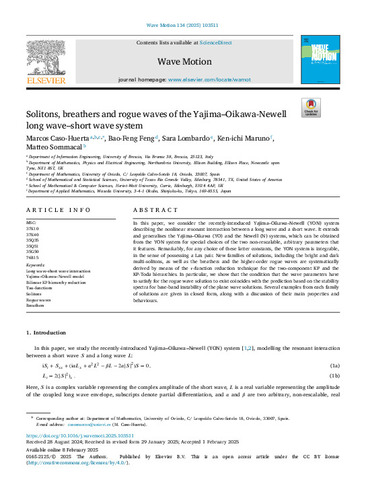Solitons, breathers and rogue waves of the Yajima–Oikawa-Newell long wave–short wave system
Autor(es) y otros:
Palabra(s) clave:
Long wave-short wave interaction
Yajima–Oikawa–Newell model
Bilinear KP hierarchy reduction
Tau-functions
Solitons
Rogue waves
Breathers
Fecha de publicación:
Versión del editor:
Citación:
Resumen:
In this paper, we consider the recently-introduced Yajima–Oikawa–Newell (YON) system describing the nonlinear resonant interaction between a long wave and a short wave. It extends and generalises the Yajima–Oikawa (YO) and the Newell (N) systems, which can be obtained from the YON system for special choices of the two non-rescalable, arbitrary parameters that it features. Remarkably, for any choice of these latter constants, the YON system is integrable, in the sense of possessing a Lax pair. New families of solutions, including the bright and dark multi-solitons, as well as the breathers and the higher-order rogue waves are systematically derived by means of the τ-function reduction technique for the two-component KP and the KP-Toda hierarchies. In particular, we show that the condition that the wave parameters have to satisfy for the rogue wave solution to exist coincides with the prediction based on the stability spectra for base-band instability of the plane wave solutions. Several examples from each family of solutions are given in closed form, along with a discussion of their main properties and behaviours.
In this paper, we consider the recently-introduced Yajima–Oikawa–Newell (YON) system describing the nonlinear resonant interaction between a long wave and a short wave. It extends and generalises the Yajima–Oikawa (YO) and the Newell (N) systems, which can be obtained from the YON system for special choices of the two non-rescalable, arbitrary parameters that it features. Remarkably, for any choice of these latter constants, the YON system is integrable, in the sense of possessing a Lax pair. New families of solutions, including the bright and dark multi-solitons, as well as the breathers and the higher-order rogue waves are systematically derived by means of the τ-function reduction technique for the two-component KP and the KP-Toda hierarchies. In particular, we show that the condition that the wave parameters have to satisfy for the rogue wave solution to exist coincides with the prediction based on the stability spectra for base-band instability of the plane wave solutions. Several examples from each family of solutions are given in closed form, along with a discussion of their main properties and behaviours.
ISSN:
Patrocinado por:
The work of MC-H was supported by the Progetti di Ricerca di Interesse Nazionale–PRIN (Project No. 2020X4T57A) and the PRIN funded by the European Union–Next Generation (Project No. 20222NCTCY). The work of BF-F was partially supported by U.S. Department of Defense (DoD), Air Force for Scientific Research (AFOSR) under grant No. W911NF2010276. MC-H and MS would like to thank the QJMAM Fund for Applied Mathematics, managed by the IMA, for supporting their attendance to the ICIAM 2023 in Tokyo, facilitating their interaction with B-FF and KM. MC-H, SL and MS would like to thank the Isaac Newton Institute for Mathematical Sciences, Cambridge, for support and hospitality during the programme Emergent phenomena in nonlinear dispersive waves, where work on this paper was undertaken. This work was supported by EPSRC grant EP/R014604/1. The work of MC-H and MS has been carried out under the auspices of the Italian GNFM (Gruppo Nazionale Fisica Matematica), INdAM (Istituto Nazionale di Alta Matematica), which is gratefully acknowledged.
Colecciones
- Artículos [37549]
- Matemáticas [326]
Ficheros en el ítem





